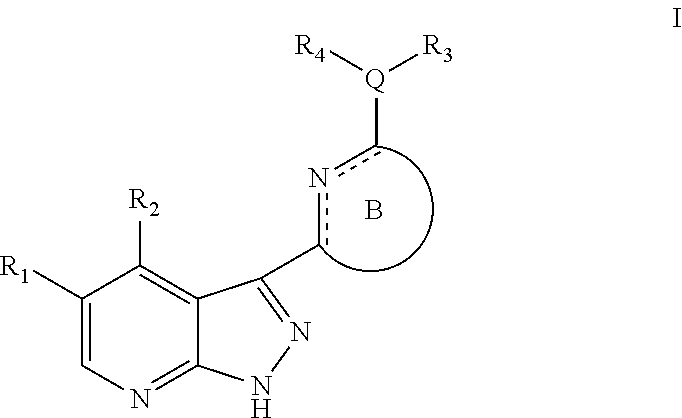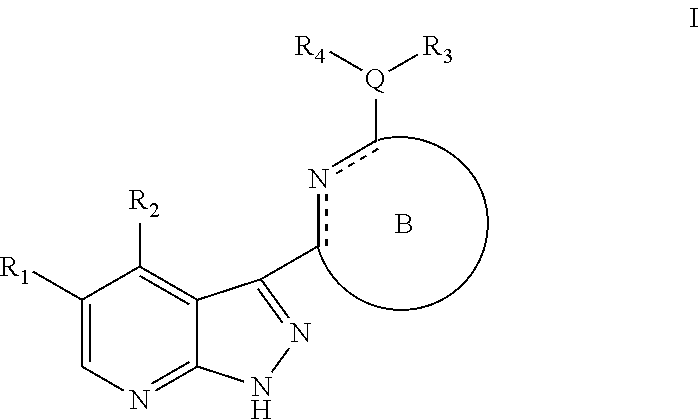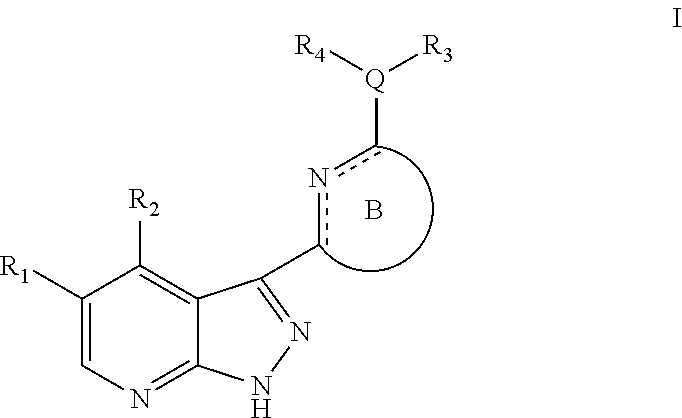Pyrazolopyridine kinase inhibitors
a kinase inhibitor and pyrazolopyridine technology, applied in the field of pyrazolopyridine kinase inhibitors, can solve the problems of pkc-theta deficient mice, inability to wage normal th2 t cell responses, and inability to clear i>listeria monocytogenes, and achieve the effect of treating or preventing a protein kinase-mediated
- Summary
- Abstract
- Description
- Claims
- Application Information
AI Technical Summary
Benefits of technology
Problems solved by technology
Method used
Image
Examples
example 1
N-((4-aminocyclohexyl)methyl)-6-(1H-pyrazolo[3,4-b]pyridin-3-yl)pyridin-2-amine
[0292]
3-(6-bromopyridin-2-yl)-1H-pyrazolo[3,4-b]pyridine
[0293]A 2.5M BuLi solution in hexane (55 ml, 131 mmol, 1.05 eq.) was added dropwise over 20 minutes to a grey suspension of dibromopyridine (31 g, 137 mmol, 1 eq) in THF (300 ml), cooled to T2 / Et2O bath). Temperature was kept at −95° C.4Cl aqueous solution (20 ml). The reaction mixture was diluted with diethyl ether (400 ml) and washed with a saturated sodium bicarbonate aqueous solution (100 ml) and brine (100 ml). The organic layer was dried over magnesium sulfate and concentrated in vacuo. The yellow solid obtained was triturated in a PE / Et2O (8-2) mixture and filtered. The residue was taken up in a solution of 1M hydrazine in THF (˜250 ml) and stirred in a sealed tube at 80° C. overnight. A solid had precipitated and was filtered off (filtrate 1). The solid was triturated in methanol and filtered off (solid 1). The filtrate 1 was concentrated, tr...
example 2
N1-(6-(1H-pyrazolo[3,4-b]pyridin-3-yl)pyridin-2-yl)-2-methylpropane-1,2-diamine (Compound 1)
[0299]
[0300]A 2.5M BuLi solution in hexane (30 ml, 75 mmol) was added dropwise over 20 minutes to a grey suspension of dibromopyridine (16.92 g, 71.43 mmol) in THF (300 ml), cooled to T−90° C. with saturated NH4Cl solution and diluted with diethyl ether, washed with saturated aqueous sodium bicarbonate and brine and dried over MgSO4. The mixture was purified by flash chromatography (Companion; 330 g SiO2; Petroleum ether / EtOAc 0 to 50%). Relevant fractions were combined and concentrated under reduced pressure to give the required product as a white solid. Yield=9 g, 45%.
[0301]ES+ 282.85, 1H NMR (400.0 MHz, CDCl3) d 7.35 (m, 1H), 7.71 (m, 1H), 7.80 (m, 1H), 8.05 (m, 1H), 8.21 (m, 1H) and 8.42 (m, 1H) ppm
[0302]A mixture of (6-bromo-2-pyridyl)-(2-fluoro-3-pyridyl)methanone (10 g, 35.6 mmol) and 1M hydrazine in THF (39.14 ml, 39.14 mmol) was combined and stirred at 80° C. overnight in a sealed tu...
example 3
N-((4-aminocyclohexyl)methyl)-6-(1H-pyrazolo[3,4-b]pyridin-3-yl)-5-(trifluoromethyl)pyridin-2-amine (Compound 25)
[0306]
[0307]To a solution of 6-chloro-2-iodo-3-(trifluoromethyl)pyridine (2.2 g, 7.156 mmol) in THF (20.51 mL), cooled to −78° C., was added isopropyl magnesium chloride 2M in THF (3.649 mL of 2 M, 7.299 mmol) and the solution stirred for 15 mins. A solution of 2-fluoro-N-methoxy-N-methyl-pyridine-3-carboxamide (1.450 g, 7.872 mmol) in THF (4.631 mL) was added (over approx 1 min) and the resultant brown solution stirred at −78° C. for 1 hr. Reaction was quenched at −78° C. by addition of saturated NH4Cl and diluted with ethyl acetate. Organic layer was washed with brine, dried (MgSO4) and concentrated to give a yellow oil. Purified by column chromatography eluting with a 0-30% EtOAc / Pet ether system. Relavant fractions collated and evaporated to dryness to give the required product as a yellow oil. Yield=1.13 g, 52%.
[0308]ES+ 304.90, 1H NMR (400.0 MHz, CDCl3) d 7.44 (m, 1...
PUM
| Property | Measurement | Unit |
|---|---|---|
| temperature | aaaaa | aaaaa |
| run time | aaaaa | aaaaa |
| run time | aaaaa | aaaaa |
Abstract
Description
Claims
Application Information
 Login to View More
Login to View More - R&D
- Intellectual Property
- Life Sciences
- Materials
- Tech Scout
- Unparalleled Data Quality
- Higher Quality Content
- 60% Fewer Hallucinations
Browse by: Latest US Patents, China's latest patents, Technical Efficacy Thesaurus, Application Domain, Technology Topic, Popular Technical Reports.
© 2025 PatSnap. All rights reserved.Legal|Privacy policy|Modern Slavery Act Transparency Statement|Sitemap|About US| Contact US: help@patsnap.com



